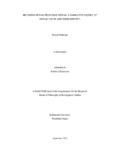
Please use this identifier to cite or link to this item:
https://hdl.handle.net/20.500.14301/548| Title: | Becoming Newar from Half-Newar: A Narrative Inquiry of Newar Youth and their Identity |
| Authors: | Maharjan, Dikesh |
| Citation: | Maharjan,D.(2025). Becoming Newar from Half-Newar: A Narrative Inquiry of Newar Youth and their Identity |
| Issue Date: | Sep-2025 |
| Publisher: | Kathmandu University School of Education |
| School: | SOED |
| Department: | DODE |
| Level: | M.Phil. |
| Program: | MPhil in Development Studies |
| Abstract: | This dissertation brings in the journey of Newar youths in their identity reclamation through learning Nepal Bhasa and Ranjana Lipi. Those journeys were presented through narratives of their lived experiences while advocating for their losing identity while also resisting dominance from other languages and promoting revitalization. Realizing this, the study explored the historical decline of Nepal Bhasa and Ranjana Lipi and the immerging journey for its revitalization. The purpose of this dissertation is to explore how Newar Youths are reclaiming their cultural and ethnic identity through learning of the Nepal Bhasa and Ranjana Lipi The study was guided by multiple theories- from Phillipson’s Linguistic Imperialism (Phillipson, 1992) and Gramsci’s Cultural Hegemony (Gramsci, 1971 as cited in Bates, 1975), to Phinney’s Ethnic Identity Development (Phinney, 1993) and Bourdieu’s Symbolic Power (Bourdieu, 1991). This study presents how Newar youths rejuvenating the once suppressed historical language and script through learning and teaching them while also using innovative activism. The study starts from the personal detachment for being unable to read the historical inscriptions on an ancient gate in my home town and being labelled as Half- Newar. That was just as representation of huge intergenerational cultural disconnect among the youths regarding their culture and identity. Thus, through those narratives, the study brings in the journey of identity reclamation with Nepal Bhasa and Ranjana Lipi which was not just ordinary learning of the language but a strategic initiation for identity reclamation while also protecting the heritage. My research relied on a narrative inquiry. In this sense, I was conscious that the ideas are multiple, and no interpretation is fixed. Semi-structured in-depth interviews were conducted among four participants for their narratives on their journey. The narratives from the participants revealed Newar youths were brought into the state of realization after a long period of dominance in a growing mixed community. Various innovative events like Lipi guff and Callijatra workshops and also curriculum development of local public schools are changing the public perception and linguistic space for Nepal Bhasa and Ranjana Lipi. The study adapted time, sociality and place factor to make the narratives more authentic and maintain the quality. The study also advocates for shifting the blame on youths for being distant from their culture and being irresponsible in preserving their culture. Rather, it brings Newar youths as the new cultural agents who are misunderstood, used less not useless. So, it demands for the change is situation from grieving for language and culture loss to promoting them, from placing blame to youths to supporting them and from state promises and symbolic gestures of preservation and commitments to real actions of change. This study challenges the well-established narrative with Newar community about the youths being culturally detached and failing to bear the accountability to its preservation. Rather, it presents them as cultural ambassadors and proving them of being used less than useless. It advocates for prioritizing intergenerational solidarity, communal ownership and the lived experiences of the youths as the ultimate strategy for cultural survival. At the end this study also found that the revitalization efforts were largely influenced by the socio-economic circumstance of the youths as it could slower or speed up the revitalization efforts so suggest not to ignore this as well. |
| URI: | https://hdl.handle.net/20.500.14301/548 |
| Appears in Collections: | Dissertations |
Files in This Item:
| File | Description | Size | Format | |
|---|---|---|---|---|
| Dikesh Maharjan Final Draft WCC.pdf | 913.35 kB | Adobe PDF |  View/Open |
Items in DSpace are protected by copyright, with all rights reserved, unless otherwise indicated.